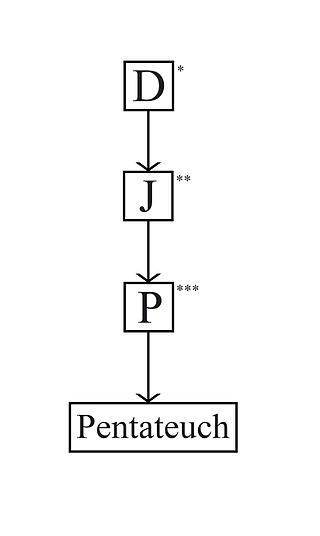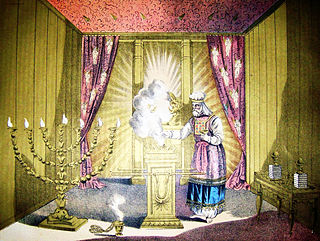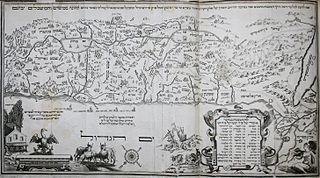
According to Abrahamic religions, Aaron was a prophet, a high priest, and the elder brother of Moses. Information about Aaron comes exclusively from religious texts such as the Hebrew Bible, the New Testament, and the Quran.
The Book of Numbers is the fourth book of the Hebrew Bible and the fourth of five books of the Jewish Torah. The book has a long and complex history; its final form is possibly due to a Priestly redaction of a Yahwistic source made sometime in the early Persian period. The name of the book comes from the two censuses taken of the Israelites.
The Book ofLeviticus is the third book of the Torah and of the Old Testament, also known as the Third Book of Moses. Many hypotheses presented by scholars as to its origins agree that it developed over a long period of time, reaching its present form during the Persian Period, from 538 to 332 BC, although this is disputed.

The documentary hypothesis (DH) is one of the models used by biblical scholars to explain the origins and composition of the Torah. A version of the documentary hypothesis, frequently identified with the German scholar Julius Wellhausen, was almost universally accepted for most of the 20th century. It posited that the Pentateuch is a compilation of four originally independent documents: the Jahwist (J), Elohist (E), Deuteronomist (D), and Priestly (P) sources. The first of these, J, was dated to the Solomonic period. E was dated somewhat later, in the 9th century BCE, and D was dated just before the reign of King Josiah, in the 7th or 8th century BCE. Finally, P was generally dated to the time of Ezra in the 5th century BCE. The sources would have been joined at various points in time by a series of editors or "redactors".
Kohen is the Hebrew word for "priest", used in reference to the Aaronic priesthood, also called Aaronites or Aaronides. They are traditionally believed and halakhically required to be of direct patrilineal descent from the biblical Aaron, brother of Moses, and thus belong to the Tribe of Levi.

According to the Hebrew Bible, the tabernacle, also known as the Tent of the Congregation, was the portable earthly dwelling used by the Israelites from the Exodus until the conquest of Canaan. Moses was instructed at Mount Sinai to construct and transport the tabernacle with the Israelites on their journey through the wilderness and their subsequent conquest of the Promised Land. After 440 years, Solomon's Temple in Jerusalem superseded it as the dwelling-place of God.

The Jubilee is the year that follows the passage of seven “weeks of years”. This fiftieth year deals largely with land, property, and property rights. According to regulations found in the Book of Leviticus, certain indentured servants would be released from servitude, some debts would be forgiven, and everyone was supposed to return to their own property in jubilee years.
According to the Bible, Gershom was the firstborn son of Moses and Zipporah. The name means "a stranger there" in Hebrew,, which the text argues was a reference to Moses' flight from Egypt. Biblical scholars regard the name as being essentially the same as Gershon and in the Book of Chronicles the progenitor of one of the principal Levite clans is sometimes identified as Gershom, sometimes as Gershon.

The Law of Moses, also called the Mosaic Law, is the law said to have been revealed to Moses by God. The term primarily refers to the Torah or the first five books of the Hebrew Bible.

The Priestly source is perhaps the most widely recognized of the sources underlying the Torah, both stylistically and theologically distinct from other material in it. It is considered by most scholars as the latest of all sources, and “meant to be a kind of redactional layer to hold the entirety of the Pentateuch together,” It includes a set of claims that are contradicted by non-Priestly passages and therefore uniquely characteristic: no sacrifice before the institution is ordained by Yahweh (God) at Sinai, the exalted status of Aaron and the priesthood, and the use of the divine title El Shaddai before God reveals his name to Moses, to name a few.
Richard Elliott Friedman is an American biblical scholar, theologian, and translator who currently serves as the Ann and Jay Davis Professor of Jewish Studies at the University of Georgia.

The priesthood of Melchizedek is a role in Abrahamic religions, modelled on Melchizedek, combining the dual position of king and priest.
Tetzaveh, Tetsaveh, T'tzaveh, or T'tzavveh is the 20th weekly Torah portion in the annual Jewish cycle of Torah reading and the eighth in the Book of Exodus. The parashah reports God's commands to bring olive oil for the lamp, make sacred garments for the priests, conduct an ordination ceremony, and make an incense altar.

Tzav, Tsav, Zav, Sav, or Ṣaw is the 25th weekly Torah portion in the annual Jewish cycle of Torah reading and the second in the Book of Leviticus. The parashah teaches how the priests performed the sacrifices and describes the ordination of Aaron and his sons. The parashah constitutes Leviticus 6:1–8:36. The parashah is made up of 5,096 Hebrew letters, 1,353 Hebrew words, 97 verses, and 170 lines in a Torah scroll. Jews read it the 24th or 25th Sabbath after Simchat Torah, generally in the second half of March or the first half of April.

In Judaism, the High Priest of Israel was the head of the Israelite priesthood. He played a unique role in the worship conducted in the Tabernacle and later in the Temple in Jerusalem, as well as in some non-ritual matters. Like all priests, he was required to be descended from Aaron. But unlike other priests, the high priest followed more restrictive laws, wore unique priestly garments, and was the only priest allowed to perform certain ceremonies.
Prolegomena zur Geschichte Israels is a book by German biblical scholar and orientalist Julius Wellhausen (1844–1918) that formulated but did not found the documentary hypothesis, a theory on the composition history of the Torah or Pentateuch. Influential and long debated, the volume is often compared for its impact in its field with Charles Darwin's 1859 work, On the Origin of Species.
In Judaism, the instructions of the priests are the rulings and teachings of the priests that are addressed to the Jewish people. Numerous Biblical passages attest to the role of the priests in teaching Torah to the people and in issuing judgment. Later rabbinic statements elaborate on these roles. However, the priest's religious authority is not automatic: even a bastard who is a scholar takes precedence over an ignorant high priest.
According to Judaism, the priestly covenant is the biblical covenant that God gave to Aaron and his descendants, the kohanim. This covenant consisted of their exclusive right to serve in the Temple, and to consume sacrificial offerings and receive other priestly gifts.
The Sons of Zadok are a family of priests (kohanim), descended from Zadok, described in the prophecies of Ezekiel.

According to the Bible, the Tribe of Levi is one of the tribes of Israel, traditionally descended from Levi, son of Jacob. The descendants of Aaron, who was the first High Priest of Israel, were designated as the priestly class, the Kohanim.










